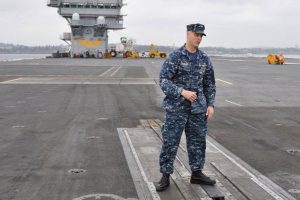Supercarrier USS Nimitz visits Esquimalt
By Lookout on Jun 23, 2014 with Comments 0

Capt J. J. ‘Yank’ Cummings, Nimitz’s Executive Officer and a former naval aviator, gives an informational tour of flight operations on the carrier’s flight deck.
The hulking silhouette of USS Nimitz, a United States Navy (USN) aircraft carrier and lead ship of the Nimitz-class, was an impressive sight on the water during its stay in Esquimalt from June 13-16.
“We pass by here every time we get underway thinking ‘Wow, it would be great to pull into Victoria.’ So we’re pleased to be here,” said Captain Jeffery Ruth, Nimitz’s Commanding Officer.
Arriving from its home port of Naval Station Everett in Washington state, “Old Salt”, the carrier’s official nickname, laid at anchor off Royal Roads near CFB Esquimalt.
Here for a brief port visit before proceeding to Canadian Forces Maritime Experimental Test Range Nanoose Bay, Nimitz arrived in Esquimalt with over 2,800 sailors and family members on board. With the addition of the carrier’s air component, Carrier Air Wing Eleven, the ship’s personnel would number well over 5,000; however the Wing remained in California.
Despite the absence of the carrier’s Air Wing, media were given an informational tour of air operations on Nimitz’s massive flight deck by Captain J.J. “Yank” Cummings, Nimitz’s Executive Officer and a former naval aviator.
Capt Cummings described the force behind the carrier’s catapult aircraft launching system as a “40-tonne double-barrel shotgun below deck.”
The launching procedure is an intricate process that involves a number of personnel on the flight deck working in close conjunction with one another amongst explosives, jet blasts and steam-driven launching catapults.
“It’s one of the most dangerous places on earth,” stressed Capt Cummings.
When the aircraft and catapult are primed for launch, the press of a button releases a massive amount of force, literally flinging the aircraft off of the flight deck. “When you salute and that button is pushed, there is nothing on God’s green Earth that will stop you from going off the front end,” said Capt Cummings. “It’s the ride of a life-time.”
Landings on the flight-deck, or “trappings” as they are called, are a more precarious business. With such a short space for aircraft to come to a halt, aircraft carriers use an arrested recovery system in which an aircraft’s tailhook catches onto a steel wire rope laid across the flight deck in order to come to a stop.
Unlike conventional landings, pilots executing a carrier landing will push their engines to full power so the aircraft can quickly take-off again in the event it misses the cables, what’s known as a “bolter”.
Capt Cummings described the intense physical and mental strain on pilots performing carrier landings.
“Imagine: no moon, lousy weather and the deck pitching 20 feet… a thousand miles from land and low on gas. I’ve done it so many times where you get out and say, ‘Oh my God, I’m glad I stopped.”
With over 750 trappings under his belt, Capt Cummings recalled the intense rush of adrenaline from carrier landings that often left him with “sewing machine legs.”
While in port, Nimitz crew members also took the opportunity to participate in community service and volunteer work. Sailors from the carrier competed against Royal Canadian Navy (RCN) members in basketball and baseball games, served lunch at Our Place Society homeless shelter, participated in a beach clean-up at Clover Point, and visited the Broadmead Care Society.
Nimitz’s command team were busy engaging with the community as well. Rear Admiral Dee Mewbourne, Commander of United States Navy (USN) Carrier Strike Group 11, and Capt Ruth were on hand to speak with local media about the carrier and the USN’s partnership with Canada.
“She has a long and distinguished history. The number of sailors that have been aboard makes it very special,” said RAdm Mewbourne about the 39-year-old carrier. “When people think ‘aircraft carrier’, Nimitz comes to mind.”
Asked about the interoperability between warships of the RCN and the Carrier Strike Groups of the USN, RAdm Mewbourne noted that, “There has been no stronger partner across the board than Canada.”
Capt Ruth was also present to recite astonishing facts and figures about Nimitz’s day-to-day operations.
“Fully embarked, with our Air Wing aboard, we have a crew of over 5,000. We produce about 400,000 gallons of water per day and there are seven different places to have a meal on board.”
USS Nimitz is a United States Navy supercarrier and the lead ship of its class. Displacing over 90,000 tonnes and able to carry approximately 65 fixed-wing and helicopter aircraft, Nimitz is an integral part of the USN’s force projection capabilities. The last time a United States Navy aircraft carrier visited Victoria was in 2010, while Nimitz last visited in 2002.
Jamie Cook, MARPAC Public Affairs
Filed Under: Top Stories
About the Author:





